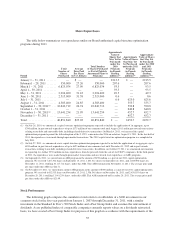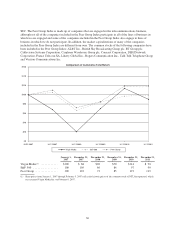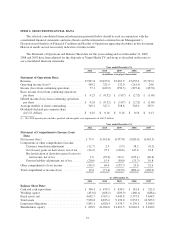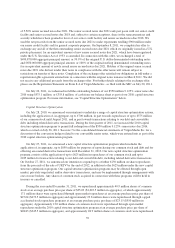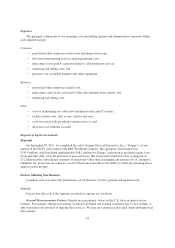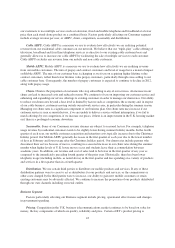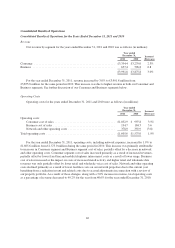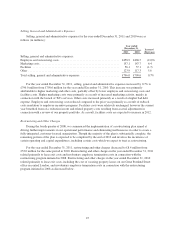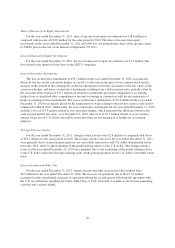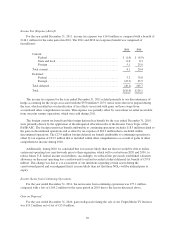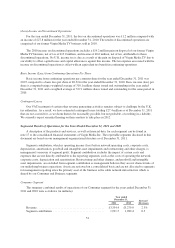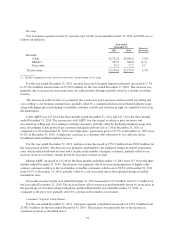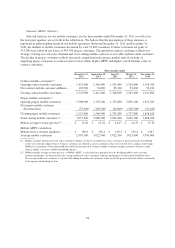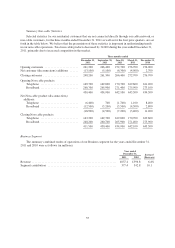Virgin Media 2011 Annual Report Download - page 46
Download and view the complete annual report
Please find page 46 of the 2011 Virgin Media annual report below. You can navigate through the pages in the report by either clicking on the pages listed below, or by using the keyword search tool below to find specific information within the annual report.Costs Associated with Construction and Installation Activities
Labor and overhead costs directly related to the construction and installation of fixed assets, including
payroll and related costs of some employees and related rent and other occupancy costs, are capitalized. The
payroll and related costs of some employees that are directly related to construction and installation activities are
capitalized based on specific time devoted to these activities where identifiable. In cases where the time devoted
to these activities is not specifically identifiable, we capitalize costs based upon estimated allocations. Costs
associated with initial customer installations are capitalized. The costs of reconnecting the same service to a
previously installed premise are charged to expense in the period incurred. Costs for repairs and maintenance are
charged to expense as incurred.
The nature and amount of labor and other costs to be capitalized with respect to construction and installation
activities involves significant judgment. In addition to direct external and internal labor and materials, we also
capitalize other costs directly attributable to our construction and installation activities. We continuously monitor
the appropriateness of our capitalization policy and update the policy when necessary to respond to changes in
facts and circumstances, such as the development of new products and services, and changes in the manner that
installations or construction activities are performed.
Taxes
As of December 31, 2011 we had gross deferred tax assets, including capital losses and net operating losses
totaling £6,026.9 million. We are required to apply significant judgment regarding future events in determining
the likelihood that we will be able to utilize these assets to reduce taxable income in future periods. We consider
historical results, tax planning strategies, and future taxable income when performing this evaluation. We record
a valuation allowance on tax assets that we believe are unlikely to be utilized to reduce taxable income in the
future. As of December 31, 2011, the allowance recorded was £5,993.0 million which reduced our gross deferred
tax assets to a net value of £33.9 million, because of our assessment of our inability to benefit from these tax
assets in the future.
In assessing the likelihood regarding the utilization of tax assets, we apply the rules in the Income Taxes
Topic of the FASB ASC. Based on our application of these rules, we determined that our cumulative pre-tax
losses over the three year period ended December 31, 2011 represent a significant piece of negative evidence that
require us to conclude that it is unlikely that we will be able to utilize any of these tax assets to reduce future
taxable income. If we continue to generate pre-tax income as we have done in the year ended December 31, 2011
such that we are not in a cumulative loss position over the most recent three year measurement period, we will
place more weight on other factors, including our projections of future profitability, and may change our
assessment of the likelihood of utilizing a portion of these assets; however, no assurances can be provided that
our future results will be consistent with our results for the year ended December 31, 2011.
New Accounting Pronouncements
In June 2011, the FASB issued new guidance to improve the comparability, consistency, and transparency
of financial reporting and to increase the prominence of items reported in other comprehensive income. The new
standard will require companies to retrospectively present items of net income, items of other comprehensive
income and total comprehensive income in one continuous statement or two separate consecutive statements, and
companies will no longer be allowed to present items of other comprehensive income in the statement of
stockholders’ equity. This new guidance is effective for financial statements issued for fiscal years and interim
periods beginning after December 15, 2011. The adoption of this standard will not have a material impact on our
consolidated financial statements.
New accounting rules and disclosures can significantly impact our reported results and the comparability of
our financial statements. There are new proposals under development regarding revenue and leasing transactions
which, if and when enacted, may have a material impact on our financial reporting.
45


